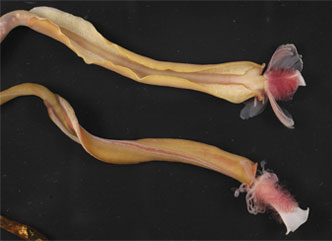Unknown extremophile species discovered in seas off New Zealand
Unknown extremophile species discovered in seas off New Zealand
mongabay.com
November 20, 2006
An international team of scientists has found bizarre creatures living around deep-sea methane seeps off New Zealand’s eastern coast.
Colorful tube worms, bacterial mats, corals, and sponges were among the organisms found living in the extreme environment where methane gas serves as the primary energy source for the community. Scientists say that a symbiotic relationship with bacteria enables such communities to convert methane into “living matter” in the absence of sunlight through a form of chemosynthesis.
“New Zealand is one of the few places in the world where at least four types of chemosynthetic habitats occur in close proximity, allowing scientists to address key questions about the patterns of biological distribution that cannot be addressed elsewhere,” notes a news release from New Zealand’s National Institute of Water and Atmospheric Research (NIWA) which co-sponsored the expedition.
“This is the first time cold seeps have been viewed and sampled in the southwest Pacific, and will greatly contribute to our knowledge of these intriguing ecosystems,” said Dr. Amy Baco-Taylor, from the Woods Hole Oceanographic Institution (WHOI) in Massachusetts, who co-led the expedition with Dr Ashley Rowden from NIWA. “The seeps off New Zealand are also remarkable in the sheer extent of their chemosynthetic communities.”

Deep-sea tube worms found around a methane seep off New Zealand’s east coast during Tangaroa’s voyage. |
The research team, which also included scientists from the Scripps Institution of Oceanography, the University of Hawaii at Manoa, and the U.S. National Oceanographic and Atmospheric Administration’s Office of Ocean Exploration, used sophisticated sonar to find potential deep-sea seep sites. The scientists then used a video camera system to documents the underwater flora and fauna.
“We’ve collected samples of the animals living around the seeps for formal identification, but the distance to previously studied cold seeps implies that there are several species new to science among these new collections,” said Dr Rowden.
Surprisingly, the team also found evidence of human impact on the communities which lie at a depth of 750—1050 meters (2400-3400 feet).
“At all of the seep sites, there was evidence of fishing damage in the form of trawl marks, lost fishing gear, and extensive areas of deep-sea coral rubble,” said report.
RELATED
Picture of newly discovered “blonde-haired” lobster
Divers found a new species of crustacean living deep in hydrothermal vents of the South Pacific. The creature resembles a lobster covered with “silky, blond” fur say researchers who made the discovery. The new crustacean, called Kiwa hirsuta, is described in the journal of the National Museum of Natural History in Paris. The animal is so distinct from other crustaceans that it has been assigned to a new family (Kiwaida) and genus (Kiwa). According to the scientists, the creature’s name is derived from Kiwa, the goddess of crustaceans in Polynesian mythology.
This article used excepts from a NIWA news release.







